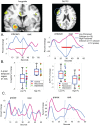Affective and neural reactivity to criticism in individuals high and low on perceived criticism
- PMID: 22984504
- PMCID: PMC3439418
- DOI: 10.1371/journal.pone.0044412
Affective and neural reactivity to criticism in individuals high and low on perceived criticism
Abstract
People who have remitted from depression are at increased risk for relapse if they rate their relatives as being critical of them on a simple self-report measure of Perceived Criticism (PC). To explore neural mechanisms associated with this we used functional magnetic resonance imaging (fMRI) to examine how people with different levels of PC responded to hearing criticism from their own mothers. To maximize variability in affective reactivity, depressed, recovered depressed, and healthy control participants (n = 33) were classified as high or low in PC based on a median split. They were then exposed to personally-relevant critical and praising comments from their mothers. Perceived Criticism levels were unrelated to depression status and to negative mood change after hearing criticism. However, compared to low PC participants, those who scored high on PC showed differential activation in a network of regions associated with emotion reactivity and regulation, including increased amygdala activity and decreased reactions in prefrontal regulatory regions when they heard criticism. This was not the case for praise. Criticism may be a risk factor for relapse because it helps to "train" pathways characteristic of depressive information processing. The Perceived Criticism measure may help identify people who are more susceptible to this vulnerability.
Conflict of interest statement
Figures



Similar articles
-
Activation in dorsolateral prefrontal cortex in response to maternal criticism and praise in recovered depressed and healthy control participants.Biol Psychiatry. 2005 Apr 1;57(7):809-12. doi: 10.1016/j.biopsych.2005.01.012. Biol Psychiatry. 2005. PMID: 15820239
-
Cortico-limbic response to personally challenging emotional stimuli after complete recovery from depression.Psychiatry Res. 2009 Feb 28;171(2):106-19. doi: 10.1016/j.pscychresns.2008.04.001. Epub 2009 Jan 26. Psychiatry Res. 2009. Corrected and republished in: Psychiatry Res. 2009 Apr 30;172(1):83-91. doi: 10.1016/j.pscychresns.2009.02.001. PMID: 19176279 Corrected and republished.
-
Prefrontal TDCS attenuates medial prefrontal connectivity upon being criticized in individuals scoring high on perceived criticism.Brain Imaging Behav. 2019 Aug;13(4):1060-1070. doi: 10.1007/s11682-018-9927-8. Brain Imaging Behav. 2019. PMID: 29974333
-
Cortico-limbic response to personally challenging emotional stimuli after complete recovery from depression.Psychiatry Res. 2009 Apr 30;172(1):83-91. doi: 10.1016/j.pscychresns.2009.02.001. Psychiatry Res. 2009. PMID: 19452633
-
Neural Circuitry of Impaired Emotion Regulation in Substance Use Disorders.Am J Psychiatry. 2016 Apr 1;173(4):344-61. doi: 10.1176/appi.ajp.2015.15060710. Epub 2016 Jan 15. Am J Psychiatry. 2016. PMID: 26771738 Free PMC article. Review.
Cited by
-
Exposure to Criticism Modulates Left but Not Right Amygdala Functional Connectivity in Healthy Adolescents: Individual Influences of Perceived and Self-Criticism.Front Psychiatry. 2021 Jul 6;12:673805. doi: 10.3389/fpsyt.2021.673805. eCollection 2021. Front Psychiatry. 2021. PMID: 34295271 Free PMC article.
-
Attachment styles modulate neural markers of threat and imagery when engaging in self-criticism.Sci Rep. 2020 Aug 13;10(1):13776. doi: 10.1038/s41598-020-70772-x. Sci Rep. 2020. PMID: 32792601 Free PMC article.
-
Connectedness to nature and public (skin) health perspectives: results of a representative, population-based survey among Austrian residents.Int J Environ Res Public Health. 2014 Jan 20;11(1):1176-91. doi: 10.3390/ijerph110101176. Int J Environ Res Public Health. 2014. PMID: 24448634 Free PMC article.
-
Weak dorsolateral prefrontal response to social criticism predicts worsened mood and symptoms following social conflict in people at familial risk for schizophrenia.Neuroimage Clin. 2018 Jan 11;18:40-50. doi: 10.1016/j.nicl.2018.01.004. eCollection 2018. Neuroimage Clin. 2018. PMID: 29876244 Free PMC article.
-
Perceived Criticism in the Treatment of a High-Risk Adolescent.J Clin Psychol. 2017 May;73(5):570-578. doi: 10.1002/jclp.22454. Epub 2017 Jan 23. J Clin Psychol. 2017. PMID: 28112810 Free PMC article.
References
-
- Vaughn C, Leff J (1976) The influence of family and social factors on the course of psychiatric illness. Brit J Psychiat 129: 125–137. - PubMed
-
- Hooley JM, Orley J, Teasdale JD (1986) Levels of expressed emotion and relapse in depressed patients. Brit J Psychiat 148: 642–647. - PubMed
-
- Butzlaff RL, Hooley JM (1998) Expressed emotion and psychiatric relapse. Arch Gen Psychiat 55: 547–552. - PubMed
-
- O'Farrell TJ, Hooley JM, Fals-Stewart W, Cutter HSG (1998) Expressed emotion and relapse in alcoholic patients. J Cons Clin Psychol 66: 744–752. - PubMed
-
- Tarrier N, Sommerfield C, Pilgrim H (1999) Relatives’ expressed emotion (EE) and PTSD treatment outcome. Psychol Med 29: 801–811. - PubMed
Publication types
MeSH terms
Grants and funding
LinkOut - more resources
Full Text Sources
Medical

